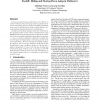Free Online Productivity Tools
i2Speak
i2Symbol
i2OCR
iTex2Img
iWeb2Print
iWeb2Shot
i2Type
iPdf2Split
iPdf2Merge
i2Bopomofo
i2Arabic
i2Style
i2Image
i2PDF
iLatex2Rtf
Sci2ools
MICRO
2008
IEEE
2008
IEEE
Facelift: Hiding and slowing down aging in multicores
Processors progressively age during their service life due to normal workload activity. Such aging results in gradually slower circuits. Anticipating this fact, designers add timing guardbands to processors, so that processors last for a number of years. As a result, aging has important design and cost implications. To address this problem, this paper shows how to hide the effects of aging and how to slow it down. Our framework is called Facelift. It hides aging through aging-driven application scheduling. It slows down aging by applying voltage changes at key times — it uses a non-linear optimization algorithm to carefully balance the impact of voltage changes on the aging rate and on the critical path delays. Moreover, Facelift can gainfully configure the chip for a short service life. Simulation results indicate that Facelift leads to more cost-effective multicores. We can take a multicore designed for a 7-year service life and, by hiding and slowing down aging, enable it to run...
| Added | 31 May 2010 |
| Updated | 31 May 2010 |
| Type | Conference |
| Year | 2008 |
| Where | MICRO |
| Authors | Abhishek Tiwari, Josep Torrellas |
Comments (0)

